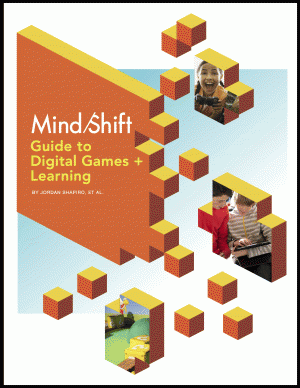Part 2 of MindShift’s Guide to Games and Learning.
 Those who still think of content as the driving force of education may not be ready for game-based learning. What do we mean by “content”? In this age of digital media, “content” is what web designers, TV producers, and media moguls talk about. Articles, TV shows, YouTube videos, photos — that’s all content. In the classroom, what we usually call content is what students have retained if teachers have met their learning objectives.
Those who still think of content as the driving force of education may not be ready for game-based learning. What do we mean by “content”? In this age of digital media, “content” is what web designers, TV producers, and media moguls talk about. Articles, TV shows, YouTube videos, photos — that’s all content. In the classroom, what we usually call content is what students have retained if teachers have met their learning objectives.
The underlying assumption of an education system that relies so heavily on test-based assessment is that content is what matters. We even call it “subject matter.” In some ways, it’s true that content matters — as long as we interpret the language so that ‘matters’ is used as a verb. Understand that “what matters” is that which is in the process of matter-ing, the process of becoming matter. What matters is what can be understood as a material, what is measurable, what is quantifiable, what is matter. Content is what matters when learning objectives are always about the measurable retention of quantifiable artifacts.
For those who prioritize learning that can be measured using only quantitative assessments, game-based learning probably just looks like a way to increase student engagement and content retention. It might seem like a complex workbook, or an entertaining quiz. Perhaps game-based learning looks like a great tool for practice and drilling, like a super sophisticated flash-card system that makes memorization more fun. But this kind of thinking doesn’t take into account the broader understanding of what matters. Game-based learning is a great classroom tool because it allows for interdisciplinary learning through contextualized critical thinking and problem solving.
Games in the classroom can encourage students to understand subject matter in context — as part of a system. In contrast to memorization, drilling, and quizzing, which is often criticized because it focuses on facts in isolation, games force players to interact with problems in ways that take relationships into account. The content becomes useful insofar as it plays a part in a larger multi-modal system.
And that’s the crux of the value: Games are all about systems thinking. Underlying every game, no matter how complex, is a relatively simple puzzle. Whether we’re talking about commercial games or learning games, at root, the player is tasked with learning a combination of actions and responses. The game does one thing. The player responds with another. In order to beat the game, the player needs to master the system.
Remember Pac-Man? The space ghosts were named Blinky, Pinky, Inky, and Clyde. They were red, pink, orange, and cyan. You may have spent hours in arcades playing Pac-Man during your teenaged years, but do you know the ghosts’ names? You can’t win at Pac-Man by remembering facts; you win a game by being able to assess phenomena, recognize systems, interpret possibilities, and iterate solutions. The ghosts’ names are decontextualized facts. Playing the game involves systems literacy.
Remember Space Invaders? Players learned very quickly to hang out at the sides, shooting the approaching aliens before they advance to the next line. If the bad guys never advance, they never get faster. What starts off as a seemingly random system, turns out to be systematic. The player learns, through trial and error, which responses are most effective, most efficient, and most likely to yield the desired result. In the process, the player becomes intimately acquainted with the system, understanding it comprehensively. “What video games do — better than any other medium,” writes games researcher and author James Paul Gee, “is let people understand a world from the inside.”
SOPHISTICATED MANIPULATIVES
Game-based learning is an instructional method that allows students to experience, understand, and solve problems in the world of a particular subject, or system, from the inside. Imagine a game that works like an instrument, but teaches mathematics. That’s how Keith Devlin, the NPR Math Guy, thinks we should teach math. We should privilege experiential mathematical thinking over the ability to memorize the particulars of the symbolic language.
Devlin believes that great game-based digital manipulatives and simulations are like mathematical instruments. Consider the piano or the guitar, if you sit down and mess around with either instrument, you can’t help but learn something about music. Bang on some piano keys. Pluck some guitar strings. You hear the relationship between tones. You internalize the difference between between dissonance and resonance. You learn a lot about music. Now, think about what happens when you add a music teacher, someone who can show you how to use the instrument, how to understand it. Suddenly you’ve opened up a world of possibility: melody, counterpoint, harmony.
Good math games are like mathematical instruments. They are sophisticated digital manipulatives that are able to provide instant feedback. Just playing with a great math game will teach you something about numbers. Just fiddle with it and you’re already doing math. But add a great teacher and the possibilities are endless. Here’s one of Devlin’s games designed to help students experience integer partitions:
With game-based learning students learn how to solve the problems in context. They understand how the equations they are solving fit into the world. The question, “Why do I need to know this?” is rendered obsolete. It is more than just subject matter, more than just content. There’s context. Students understand how integer partitions work within a system.
Creative game designers are building similar products in every discipline. Here’s one that’s meant to let students get intimately acquainted with the system of metabolism, to experience the metabolism process from the inside:
It’s a fun game, where players need to manage their resources carefully in order to win. Students need to understand how each resource plays a part in the system. In this case, it is the system of metabolism. We might call it basic biological literacy.
One promise of game-based learning is that it has the potential of building comprehension and literacy rather than retention. It does this by combining instruction, practice, and assessment. Teachers become the facilitators of a process where instruction is experiential. Practice is project based, requiring students to solve new problems and address new challenges using the new ideas to which they’ve been introduced. And assessment no longer measures a student’s ability to regurgitate information, or to choose among multiple answers, but rather, to use the content, or subject matter, in context. Even more impressive is that in order to successfully manipulate one piece within a comprehensive and complex system, the students must understand every piece of the system.
A comprehensive and experiential understanding of a closed system is important. But it’s not enough. Students also need to understand how each system plays a part in a larger world, how STEM subjects are related to the Humanities, and how multiple ways of describing the world work together to create our everyday experiences.
For far too long, learning has been separated into categories and disciplines. Next week I’ll explain how game-based learning can integrate learning, creating a multidisciplinary experience.
The MindShift Guide to Game-Based Learning is made possible through the generous support of the Joan Ganz Cooney Center and is a project of the Games and Learning Publishing Council. This is the second in a series of 20 posts.

